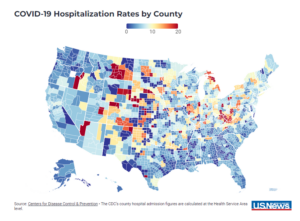The Top COVID-19 Hot Spots in the U.S.
These are the counties with the highest recent rates of new COVID-19 hospital admissions per capita.

(US News, Christopher Wolf) — COVID-19 hospitalizations in the U.S. again rose week over week, according to the latest figures from the Centers for Disease Control and Prevention.
The U.S. tallied approximately 19,400 new hospitalizations of people with COVID-19 over the seven days ending Nov. 25, according to provisional data – about 1,700 more than the total for the previous week and a rise of approximately 10%. The uptick marks the third weekly increase in a row after COVID hospitalizations in the U.S. had largely been trending downward since early September, when they totaled about 21,000.
Relative to population, data points to 5.9 new COVID-19 hospital admissions per 100,000 people for the week through Nov. 25. Nearly all states across the U.S. had a “low” level of hospitalizations per 100,000 people, according to the CDC. The exceptions – West Virginia (15.4) and South Dakota (12.0) – were characterized by the CDC as each having a “medium” level of hospitalizations. Compared with the week prior, Indiana had the highest percentage increase among states in its rate of new COVID-19 hospitalizations, at 38%. Alaska saw the largest decrease among states at 21%.
Among patients visiting a subset of emergency departments, data indicates 1.7% of visits nationally involved a COVID-19 diagnosis – a rate up about 11% from the week before. New Mexico (3.9%) and West Virginia (3.4%) saw the highest rates.
Notably, the CDC’s county hospital admission figures are calculated at the Health Service Area level, which can span multiple counties. This means counties within the same HSA will share the same admission rates in the data. Areas also may be listed as having insufficient data.
The counties with the highest rates of COVID-19 hospital admissions per 100,000 people:
- Union County, New Mexico (73.9)
- Letcher County, Kentucky (46.4)
- Richardson County, Nebraska (38.2)
- Pawnee County, Nebraska (38.2)
- Decatur County, Kansas (37.2)
- Hitchcock County, Nebraska (37.2)
- Red Willow County, Nebraska (37.2)
- Sheridan County, Kansas (37.2)
- Greene County, Illinois (36.8)
- Morgan County, Illinois (36.8)
- Scott County, Illinois (36.8)
- Petroleum County, Montana (34.7)
- Fergus County, Montana (34.7)
- Logan County, West Virginia (34.4)
- Mingo County, West Virginia (34.4)
- Pike County, Kentucky (34.4)
- Orange County, Indiana (33.8)
- Lawrence County, Indiana (33.8)
- Adams County, Idaho (31.9)
- Malheur County, Oregon (31.9)
- Washington County, Idaho (31.9)
- Payette County, Idaho (31.9)
- Phillips County, Colorado (31.1)
- Logan County, Colorado (31.1)
- Sedgwick County, Colorado (31.1)
- Knox County, Illinois (27.1)
- Warren County, Illinois (27.1)
Because hospitalization rates are calculated per 100,000 people, it’s worth noting that even a small number of hospitalizations can lead to a relatively high hospitalization rate for small communities.
Other measures also can give a sense of the current state of COVID-19. For example, though the CDC has ceased publishing a “community level” metric that incorporated COVID-19 case rates and hospital admissions – as well as the average percentage of hospital beds occupied by COVID-19 patients – participating health departments submit data from sampling and testing of wastewater for the virus to the CDC via the National Wastewater Surveillance System.
Since the U.S. passed 1 million cumulative deaths tied to COVID-19 in the spring of 2022, approximately 156,000 additional people have died in connection with the disease, according to provisional data from the CDC.
While the latest tallies are down from a recent peak of about 1,400 deaths in a week in September – and well below the maximum peak of around 26,000 deaths in a week in early 2021 – data indicates hundreds of people still have died in connection with COVID-19 of late. West Virginia saw 5.5% of its total deaths attributed to COVID-19 during the week ending Nov. 25, according to provisional data, with an additional 10 states seeing shares higher than the national percentage of 2.5%.
